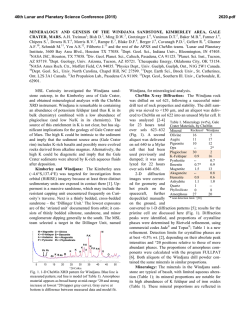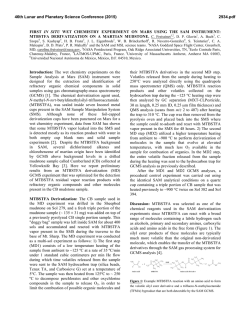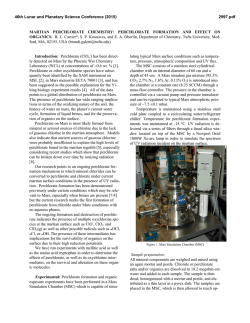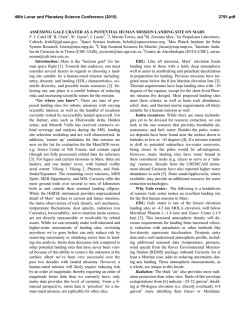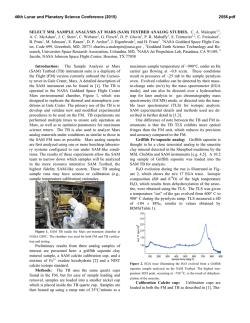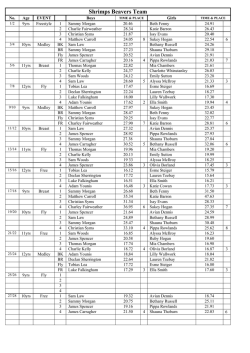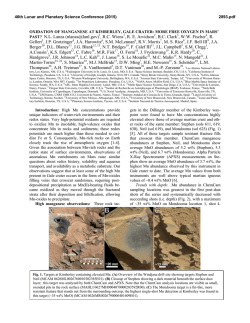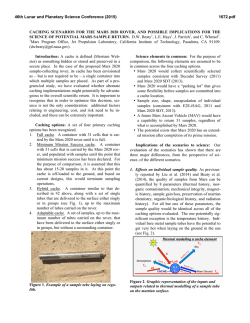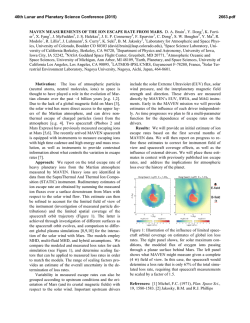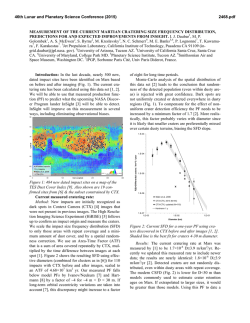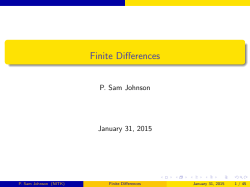
Oxychlorine Species on Mars: The Gale Crater Story - USRA
46th Lunar and Planetary Science Conference (2015) 2971.pdf OXYCHLORINE SPECIES ON MARS: THE GALE CRATER STORY. P.D. Archer, Jr1, D.W. Ming2, B. Sutter1, R.V. Morris2, B.C. Clark3, P.H. Mahaffy4, J.J. Wray5, A.G. Fairen6, R. Gellert7, A.S. Yen8, D.F. Blake9, D.T. Vaniman10, D.P. Glavin4, J.L. Eigenbrode4, M.G. Trainer4, R. Navarro-González11, C.P. McKay9, and C. Freissinet4, 1 Jacobs, NASA Johnson Space Center, Houston, TX 77058, [email protected], 2NASA Johnson Space Center, Houston, TX, 3Space Science Institute, Boulder, CO 80301, 4NASA Goddard Space Flight Center, Greenbelt, MD 20771,5Georgia Institute of Technology, Atlanta, GA 30332, 6Centro de Astrobiologia (INTA-CSIC), Madrid, Spain, 7University of Guelph, ON, Canada , 8Jet Propulsion Laboratory, Pasadena, CA 91109, 9NASA Ames Research Center, Moffett Field, CA 94035, 10Planetary Science Institute, Tucson, AZ, 11Instituto de Ciencias Nucleares, Universidad Nacional Autonoma de Mexico, Ciudad Universitaria, Mexico City, Mexico. sedimentary rocks varied substantially from 0.35 wt. % in Confidence Hills to 1.4 wt. % in the Sheepbed mudstone target Cumberland. Surprisingly, the John Klein target in the Sheepbed mudstone contained nearly 3 times less Cl than the Cumberland [5]. The Windjana sandstone contained ~0.6 wt. % Cl, slightly less than the Cl content in the global dust. Evolved O2 (mass 32) 6 20x10 counts per second Introduction: Comparing data from the AlphaParticle X-Ray Spectrometer (APXS) and the Sample Analysis at Mars (SAM) instruments on MSL reveals a strong linear correlation between chlorine and oxygen, further demonstrating the presence of oxychlorine species in Gale Crater and, very likely, globally on Mars. Perchlorate was first discovered on Mars by the Microscopy, Electrochemistry, and Conductivity Analyzer (MECA) instrument on the Phoenix lander in 2008 [1]. Current hypotheses suggest that the formation of oxychlorine species such as perchlorate or chlorate is a global process and that these species should be globally distributed on Mars [e.g. 2-4]. To date, the SAM and Chemistry and Mineralogy (CheMin) instruments on MSL have analyzed one scooped sample of aeolian material (Rocknest [RN]), and four drilled samples (John Klein [JK], Cumberland [CB], Windjana [WJ], and Confidence Hills [CH]). The APXS instrument has also investigated the same or very similar samples. Although not definitively identified, oxychlorine species have been proposed to explain releases of O2, HCl, and chlorinated hydrocarbon species detected by evolved gas analysis (EGA) with the SAM instrument [5, 6]. We report a strong linear correlation between wt. % Cl detected by APXS and moles O2 detected by SAM during pyrolysis, indicating the presence of oxychlorine species in Gale Crater. Gale Crater Samples: The RN aeolian material consists primarily of basaltic minerals [7]; in CB and JK, CheMin detected a Fe-saponite along with basaltic minerals and anhydrite, bassanite, akaganeite, and sulfides [8]; the Windjana sandstone contains high magnetite along with 2:1 phyllosilicates [9]; Confidence Hills contains the first notable detection of hematite (~ 8 wt. %) with 2:1 phyllosilicate(s) and primary basaltic minerals [10]. All five samples have a significant X-ray amorphous component (20-50 wt. %) that could contain the oxychlorine species. The Cl content of the Rocknest windblown deposit is ~0.7 wt. % [11], similar to the average soil Cl composition of ~0.7 wt. % observed for Gusev crater Laguna class soils [12]. This confirms that the Cl component is likely associated with the dust that is globally distributed [13]. The Cl composition of the four drilled Rocknest (2x) John Klein (10x) Cumberland Windjana Confidence Hills (10x) 15 10 5 0 100 200 300 400 500 600 700 800 Sample Temperature (ºC) Figure 1 - Oxygen releases from Gale Crater samples during heating by the SAM instrument. The SAM instrument has detected O2 released from every sample analyzed to date (Figure 1), consistent with the decomposition of an oxychlorine compound such as perchlorate [6]. Every sample analyzed has also included chlorinated hydrocarbons that are generally seen before the O2 release as well as an HCl release that starts around the same temperature as the O2 release but peaks between 400-800 °C [5, 6]. Results: We report here a strong linear correlation between Cl detected by APXS and O2 detected by SAM (Figure 2). A linear fit to the data gives an adjusted R2 value of 0.93. This correlation demonstrates that the O2 detected by the SAM instrument is from the decomposition of an oxychlorine species. Using an estimated 45 ± 18 mg of sample mass delivered to SAM and assuming that the O2 comes from a perchlorate or chlorate salt that decomposes to a metal oxide (e.g. Mg(ClO4)2 →MgO + Cl2O7), we can calculate the equivalent wt. % Cl in a sample based on the amount of O2 released. Dividing this number by the total wt. % Cl measured by APXS gives the total amount of Cl present in O2-releasing chlorinecontaining compounds such as perchlorate or chlorate. 46th Lunar and Planetary Science Conference (2015) SAM O2 (µmol) Plotting this ratio vs. the APXS wt. % Cl shows that the fraction of Cl present as perchlorate or chlorate increases with increasing Cl concentration (Figure 3). The data can be fit to a function of form y=a-b/x, derived from the linear relationship in Figure 2, with an adjusted R2 value of 0.95. 12 y 8.7 x 2.8 10 R 2 0.93 8 CB RN 6 4 JK 2 WJ CH 0 0.2 0.4 0.6 0.8 1.0 1.2 1.4 1.6 APXS Cl (wt. %) Figure 2 - O2 evolved from samples during thermal analysis (SAM) vs. the wt% of Cl in the samples (APXS). Data are shown from RN (runs 1-4), JK (runs 1-4), CB (runs 2, 3, 57), WJ, and CH. Error bars are the 2σ standard deviation of the intstrumental uncertainty for SAM O2 results and the analytical uncertainty for APXS results. SAM Cl/APXS Cl 0.5 0.4 0.3 CB WJ 0.2 RN JK 0.12 x 2 R 0.95 y 0.45 0.1 CH 0.0 0.2 0.4 0.6 0.8 1.0 1.2 1.4 1.6 APXS Cl (wt. %) Figure 3 – Fraction of Cl present as an oxychlorine species vs. total wt % Cl from APXS assuming all O2 came from a chlorate salt (the ratio from a perchlorate would be slightly lower). Error bars for RN, JK, and CB are the 2σ standard deviation of the average of runs listed in Figure 2 caption. Aside from the strong correlation between SAM O2 and APXS Cl that demonstrates the presence of oxychlorine compounds, the data have another important implication. In figure 2, when SAM O2 is zero, APXS Cl is not zero. Similarly, the SAM Cl/APXS Cl in figure 2 rolls over and hits a maximum at ~0.45 (for chlorate). This behavior could be explained by either the presence of a non-O2-releasing Cl compound (such as a chloride salt) or the consumption of O2 during pyrolysis by combustion of organic material or oxidation of a 2971.pdf reduced compound. If the former explanation is correct, there is a significant reservoir of unoxidized Cl on Mars in equilibrium with the oxidized compounds, which has implications for the oxychlorine formation mechanism. Alternatively, some evolved O2 could be consumed by combustion of organic material or oxidation of reduced species in the sample, reducing the amount of O2 released. Based on the detection of O2-consuming species by CheMin and the evidence for combustion of organic compounds [6], it is likely that both combustion and oxidation are occurring during pyrolysis. We are currently working to determine how much was consumed and expect the Cl-derived-from-O2 number to change to some degree. Implications: The strong correlation between evolved O2 from SAM and wt. % Cl from APXS is almost certainly due to the presence of oxychlorine species in Gale Crater samples. The Rocknest sample is chemically very similar to soils found elsewhere on Mars by APXS [12] as well as the Cl content detected by the Gamma Ray Spectrometer on the Mars Odyssey spacecraft [14]. Based on this evidence, perchlorates are globally distributed on Mars. The presence of oxychlorine species in drilled rock samples is of potentially equal importance. Samples analyzed from the Sheepbed mudstone, which is billions of years old [15], have very different O2/Cl concentrations (CB ≈ 3 x JK). Drill hole imagery reveals that the JK sample contains many more sulfate-filled veins compared to CB [8]. This implies that the oxychlorine compound was native to the mudstone and was removed through leaching during subsequent fracturing/fluid flow. This is significant because it implies that not only is perchlorate/chlorate formation occurring on Mars today, but it has been occurring throughout Mars’ history and could have played an important role in the chemistry and habitability of the planet. References: [1] Hecht, M.H., et al., (2009) Science, 325, 5936. [2] Catling, D.C., et al., (2010) JGR, 115. [3] Smith, M.L., et al., (2014) Icarus, 231. [4] Schuttlefield, J.D., et al., (2011) J. Amer. Chem. Soc., 133, 44. [5] Ming, D.W., et al., (2014) Science, 343, 6169. [6] Glavin, D.P., et al., (2013) JGR, 118, 10. [7] Bish, D.L., et al., (2013) Science, 341, 6153. [8] Vaniman, D.T., et al., (2014) Science, 343, 6169. [9] Treiman, A.H., et al., (2015) LPS XLVI, this conference. [10] Cavanagh, P.D., et al., (2015), LPS XLVI, this conference. [11] Blake, D.F., et al., (2013) Science, 341, 6153. [12] Ming, D.W., et al., (2008) JGR, 113, E12. [13] Gellert, R., et al., (2004) Science, 305, 5685. [14] Keller, J.M., et al., (2006) JGR, 111, E3. [15] Farley, K.A., et al., (2014) Science, 343, 6169.
© Copyright 2026
